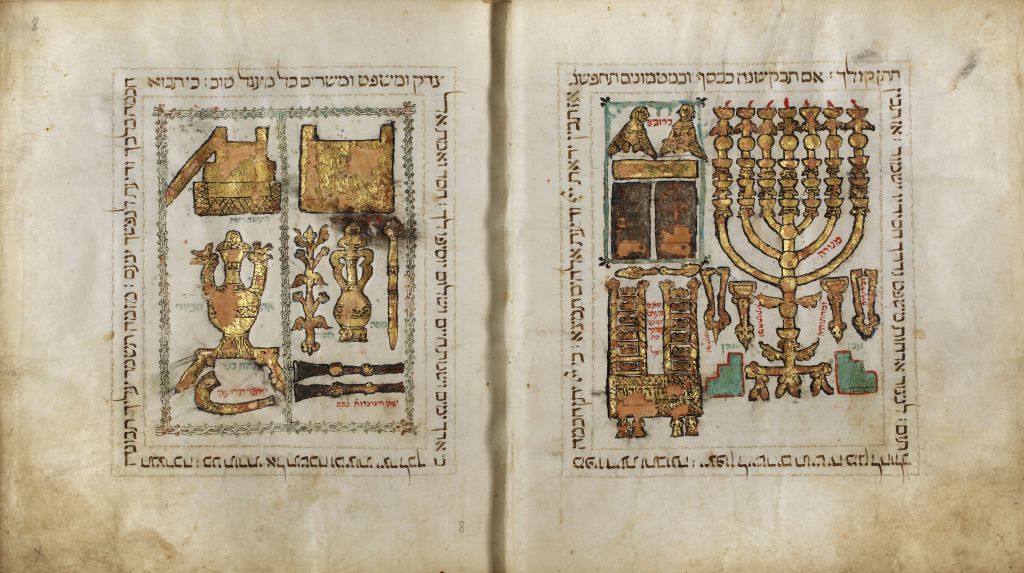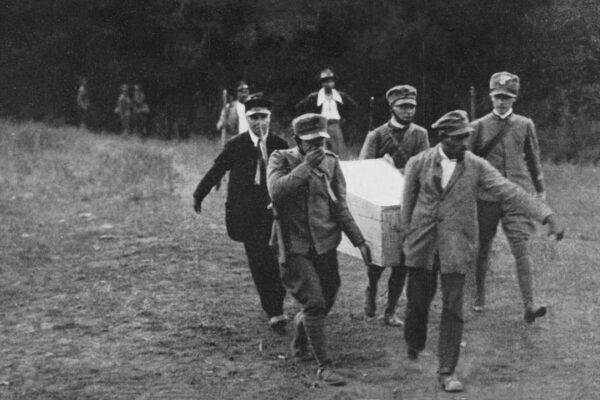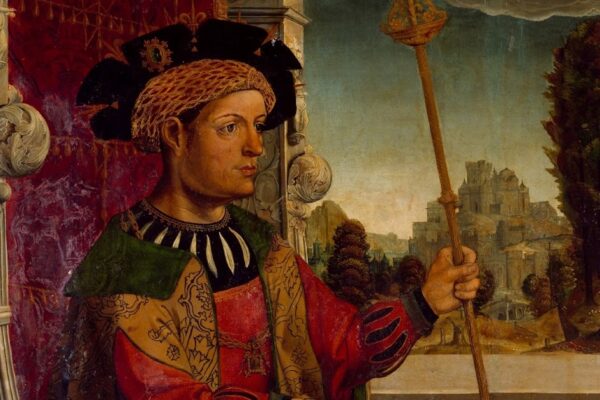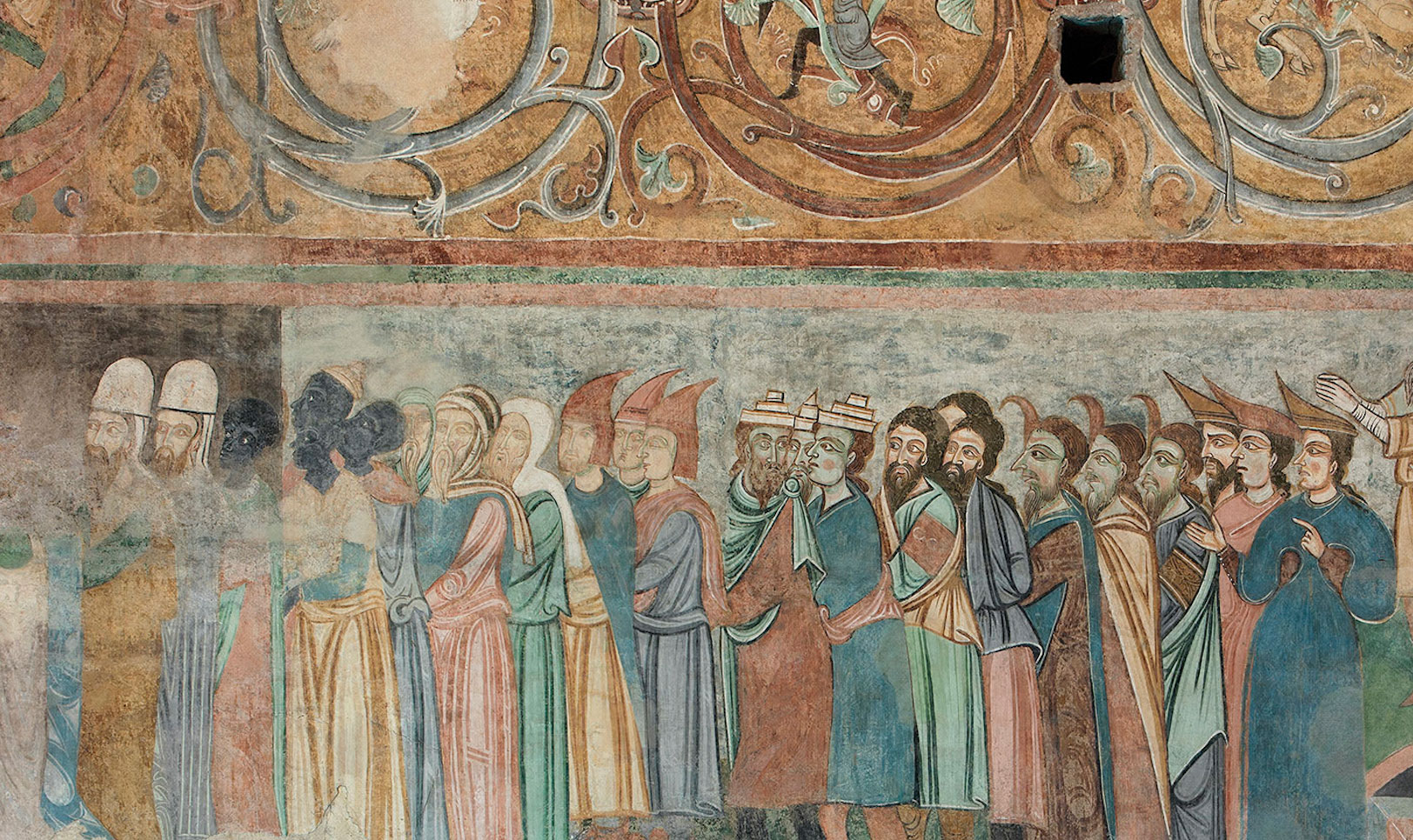The Biblioteca Palatina and the National Library of Israel – Together to Save the Books
Israel’s National Library and the Biblioteca Palatina in Parma signed an agreement based on which the Palatina’s collection of more than 1,600 Hebrew manuscripts featuring two hundred biblical items, and five hundred illuminated manuscripts, including a precious 11th century Mishna, (see image) – will become available in digital form to scholars around the world.
The idea of collecting in a single place copies of all the Hebrew manuscripts in the world was conceived by David Ben Gurion.
One of the leading scholars who have work toward this goal is Mauro Perani, professor of Hebrew at the University of Bologna. Prof. Perani is the recipient of an honorary degree from the Hebrew University for his extraordinary work in this area. Recently, Prof. Perani discovered the oldest known complete Sefer Torah the world, copied between the 12th or first 13st century. What follows is his essay on the agreement between the Biblioteca Palatina and the National Library of Israel published in Pagine Ebraiche, November 2013. (Rossella Tercatin)
Judaism developed as a civilization of the book, of its commentary and the commentaries of commentaries. Until 1455 the books were hand-produced by scribes, thus manuscripts are of central importance for Judaism.
Two years after the proclamation of the State of Israel, on March 5th, 1950, the prime minister David Ben Gurion, asked the Finance Minister Eliezer Kaplan a fund to finance the microfilming of all the Hebrew manuscripts in the world and collect them in a special institution that would make them available to the scholar of Jerusalem and the newborn Jewish state.
Since, for obvious reasons, it was impossible to gather all the Hebrew manuscripts in Jerusalem, Ben Gurion wrote: ” … our first duty is to save Jewish literature. There are thousands of Jewish manuscripts that lie forgotten in libraries … many of them have disappeared in the darkness of the past or have been destroyed by the wrath of oppressors … It is the duty of the State of Israel to acquire and collect those exiles of the spirit of Israel that are scattered in the diaspora. I do not think it is possible to acquire the original manuscripts, but … any reproductions thereof … shall have the same value of the manuscripts themselves and that we must realize this immediately, without delay and with every effort. ”
The project was realized with the creation of the Institute of Microfilmed Hebrew Manuscripts, a section of what until a few years ago was called the Jewish National and University Library in Jerusalem, now renamed National Library of Israel after being separated from the Hebrew University.
The institute’s reading room offers access to 70,000 rolls with photographs of 90% of the world’s Hebrew manuscripts, calculated to be around 90,000. Of these, only between 25,000 and 30,000 are Medieval manuscripts produced before the year 1550.
During sixty years of work, the Institute, which I had the joy of frequenting assiduously in the 1980s and 1990s, realized the microfilming of about 90% of all existing Hebrew manuscripts, scattered in 1,200 collections around the world.
Its directorship was held by preeminent cultural figures including Nehemiah Allony, David Loewinger, Malachi Beit Arié, Israel TaShma, Benjamin Richler, and currently Yael Okun Mayer, who is also director of the Manuscripts Department of the National Library. The first director, an officer of the Ministry of Culture, travelled intensely throughout Europe.
When his mandate ended in 1963, the Institute was transferred to the Jewish National and University Library in Jerusalem, at the Givat Ram Campus, where it received its current name.
A significant advancement in microfilm reproductions occurred after the fall of the Berlin wall, when -after a sequel of refusals- permission was obtained, to reproduce the rich Hebraica collections in Russia, about 20,000 manuscripts that were finally photographed in 1992.
In 1987, the card catalog was terminated, and the institute began to catalog the acquisitions electronically using the National Library’s ALEPH system.
Today the entire catalog prepared by the Institute of Microfilm, together with the catalog of 10,000 manuscripts of the National Library can be accessed online at www.nli.org.il .
One of Institute’s ongoing projects of the past thirty years, which inspired the Israeli film director Joseph Cedar in his award-winning film “Footnote”, has been the search for manuscript fragments, which had been used as binding materials in early Italian bookmaking. As alluded in the film, one of the outstanding discoveries was a copy of the Talmud, which had been used as binding material for Italian notary registries.
Scholars estimate that the very small number of medieval Hebrew manuscripts that have survived to our days amounts to approximately 5% of those that were produced in European Jewish circles during the Middle Ages. This was certainly due to the systematic destruction perpetrated by the Inquisition and to the Christian persecution aimed at converting Jews. Moreover, the conservation of the Hebrew texts by Jews was always precarious because of their intense ritual and scholarly use and of the great mobility that has always characterized Jewish life. Above all, the concern for preventing the desecration of the holy Name of God that could be contained in every Hebrew text including manuscripts, led to their being stashed in Genizot, often a transitional step before their burial. This caused a systematic disappearance for ritual reasons of Hebrew texts, and in particular of Torah scrolls that had become pesulim (improper for liturgical use being damaged or lacking of some letters).
If on the one hand the Catholic Church through the Inquisition’s banishment of the Jewish book destroyed an incalculable amount of Hebrew manuscripts, on the other hand, Catholic hebraists such as De Rossi, and libraries such as the Vatican Library have collected and preserved an impressive part of the Jewish manuscript heritage for centuries.
As my friend Benjamin Richler recently pointed out (in Italy, the “Breadbasket” of Hebrew Manuscripts in Italia Judaica the Jubilee Conference, edited by S. and J. Simonsohn Shatzmiller, Brill, 2013, p. 137-141), based on an accurate survey of the catalogs of the National Library in Jerusalem, we know that manuscripts copied in Italy or bearing ownership notes, bills of sale or censorship from Italy, represent a stunningly disproportionate number of the total known Hebrew manuscripts in the world.
Similarly to the predominant role of Italy in the production of the cultural assets that are today preserved around the world, which is estimated to amount to half or more of the total, over half of all Jewish cultural assets, in particular Hebrew manuscripts preserved in libraries and collections all over the world, come from Italy.
How is this possible? The data is impressive, if one notices that the Jewish population of the Italian peninsula has never reached the figures of hundreds of thousands or millions of people, that have characterized other geographical areas including the Sephardic world and Ashkenazi Europe.
The explanation lies in the fact that, considering the distribution of the Jewish population in Europe in the 15th century, about 20% of European Jewry, lived in Italy while about 50 % lived in Spain and Portugal. This contrasts with the situation prior to World War II, when Italy, was home to only 50,000 of the 16 million Jews in the world, a much lower percentage than that of the 15th century.
A factor that played a role in the preservation of Hebrew manuscripts in our country is that until the unification of 1861, Italy was a land made up of many small states and duchies. For two thousand years, in particular between the Middle Ages and early modern era, the Jews suffered persecution but were never expelled from the entire peninsula. When they wer expelled from a Duchy or a Kingdom, they generally moved in the closest Duchy, as for exemple in 1569 from Bologna to Ferrara, thus only 50 km away. This undoubtedly helped the century long preservation of Hebrew manuscripts that were produced locally.
In the 16th century the number of Jews living in Italy equaled that of Jews living outside of the peninsula and was twice as large as that of the Jews living in Eastern Europe. Sephardic Jews were expelled from Spain in 1492, and brought an incredible amount of their manuscripts to Italy and other regions where they settled. Exchanges also occurred with the Ashkenazy world. However, beginning in 1550 with the flourishing of book printing, manuscripts became obsolete and the profession of the scribe began to disappear.
In the following centuries, the ratio of Jews in Eastern Europe and Italy inverted, coinciding with the advent of the printed book. Manuscripts were no longer produced and Italy became their main repository. During the 18th, 19th and 20th centuries printed books circulated widely in Eastern Europe where Hebrew books were also subject to massive waves of destruction. This history may in part account for the disproportionate number of Italian Hebrew manuscripts that have survived to our days.
The creation of an International Online Hebrew Manuscript Digital Library. Today, digital reproduction of manuscripts offers incomparable quality and has almost completely replaced the use of microfilm. The future lies in the creation of an International Online Hebrew Manuscript Digital Library. This project was prepared at a conference held in Jerusalem two years ago which I was part of.
The endeavor is extraordinary, involving over 1,200 institutions around the world with the aim to scan all newly discovered Hebrew Manuscripts directly from the originals.
In August 2013, Aviad Stollman, curator of the Judaica collections at the Israel National Library, described the process of implementation of the digital manuscript archive in a “General Strategic Outline”.
Israel National Library wrote a letter to all the collectors, libraries and archives that own Hebrew manuscripts, whether whole, fragments or reused as binding. They proposed a collaboration by which INL would digitize the manuscripts and make them available at low resolution in a trans-institutional archive. To obtain scans at full resolution, users will have to make a request to the institution of origin. The digitization of the entire collection of Hebrew manuscripts will cost approximately six million dollars, a sum that INL not yet raised in full.
The project will be implemented in four stages: 1. Digitization of all the microfilms of Hebrew manuscripts. All of the microfilm owned by the Institute of Microfilm in Jerusalem will be transferred to a digital platform. Ideally all manuscript will be eventually scanned from the originals but for the time being the microfilm repository is the first source of digitization. Manuscripts preserved at the INL will be scanned anew. 2. Digitization of all manuscripts of the most important collections worldwide (within 5-6 years). Because of the importance of their Hebrew collections, the Bodleian Library in Oxford, the Vatican Library and the Palatina Library in Parma are among the first libraries to be involved in the project. A second phase will concern the British Library in London and the Bibliothèque National in Paris. 3. Digitization of Hebrew manuscripts of particular importance and significance. This stage involves the digitization of about 1,000 manuscripts that scholars of different disciplines have identified as especially valuable for historical, social or artistic reasons. 4. Treasures of Hebrew manuscripts for a wide audience. Books that are considered of interest to the general public and will be used for non-scholarly purposes. These books, representing 10% of the total number of manuscripts, will be made available to lay users through a revolutionary interactive platform. The recent agreement for the digitization of Hebrew Manuscripts of the Biblioteca Palatina in Parma. Within the scope of the above described project, INL recently signed an agreement with the Biblioteca Palatina in Parma to digitize and publish about 1,600 precious Hebrew manuscripts.
The Biblioteca Palatina operates under the Italian Ministry of Cultural Heritage and Tourism and belongs to the State of Italy. It preserves one of the most important collections of Hebrew manuscripts in the world, whose chronological span and quality of the texts, largely copied between the Middle Ages and the Renaissance, are unparalleled.
Of these holdings, 1,400 belonged to the collection of Giovanni Bernardo De Rossi (1742-1831), a Catholic priest and professor of oriental languages at the Theological Faculty of Parma, who collected the majority of manuscripts among those produced by Italian Jews. His collection included very early manuscripts such as those of the 11th century Otranto School of scribes.
After Parma fell to Austria in 1816 the De Rossi collection was acquired in by the Duchess Maria Luisa for the Biblioteca Palatina.
About 200 among the manuscripts of this magnificent collection are illustrated with beautiful miniatures and ornaments of various kinds. One of the most important codes contains a Mishnah (Ms. 3173; De Rossi 138), probably produced in the 11th century by copyists from the School of Otranto or from one of Puglia’s rabbinical academies.
It is worth noting that the manuscripts of the two Italian collections among the five that were deemed of excellence were recently catalogued with the support of the Vigevani Foundation. Benjamin Richler curated both catalogs with a paleographic description by Malachi Beit Arié. They were published respectively twelve and five years ago: The Hebrew Manuscripts in the Biblioteca Palatina of Parma, The Jewish National and University Library, The Hebrew University, Jerusalem, 2001, and The Hebrew Manuscripts of the Vatican Library, Vatican City, Biblioteca Apostolica Vaticana, 2008. Both are based on the catalogues of the Institute of Microfilm in Jerusalem, and, curiously, the second was prepared in Jerusalem as ready-to-print file and printed in Vatican City.
The unique value of the Hebrew manuscripts of the Biblioteca Palatina, which Giuliano Tamani first began to study and describe in the Nineteen Sixties and Seventies, lies in their antiquity and quality. Some were produced in Southern Italy, in the early centuries of the second millennium C.E. and were brought to central Italy in the 13th century, after the destruction of the rabbinical academies of Puglia, as described by Umberto Cassuto in an article of 1942. Subsequently they were taken to the Northern regions, some ending up in the De Rossi collection or dismembered and reused as bindings in the archives of Bologna and Modena.









